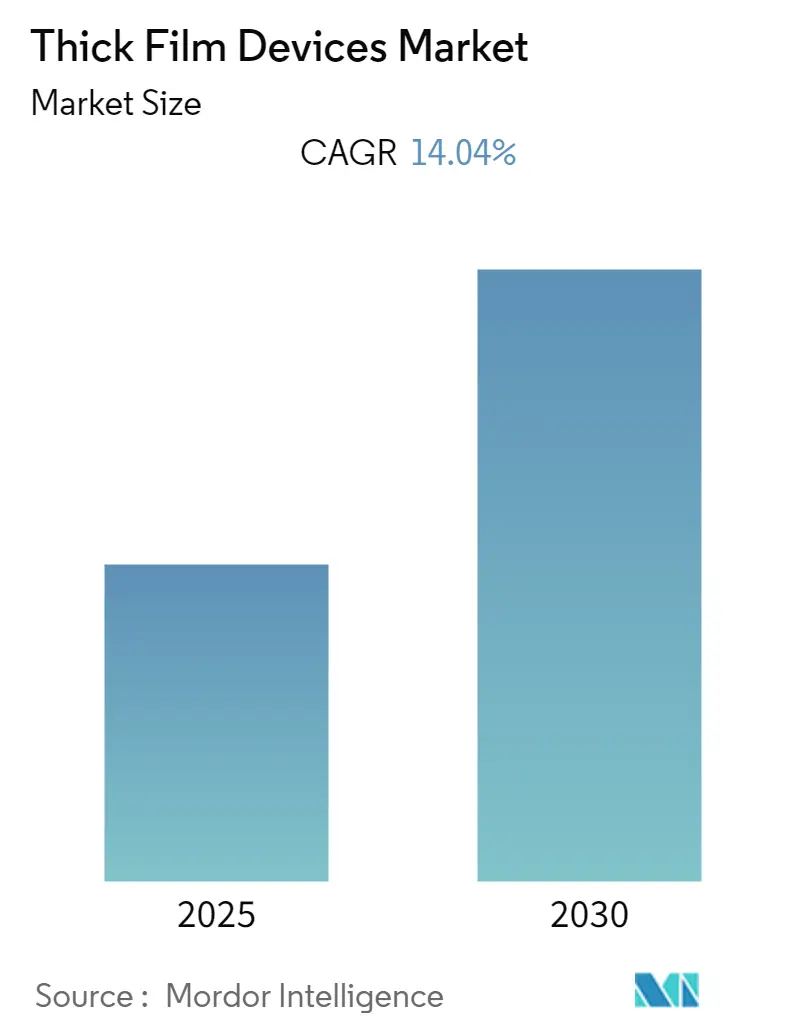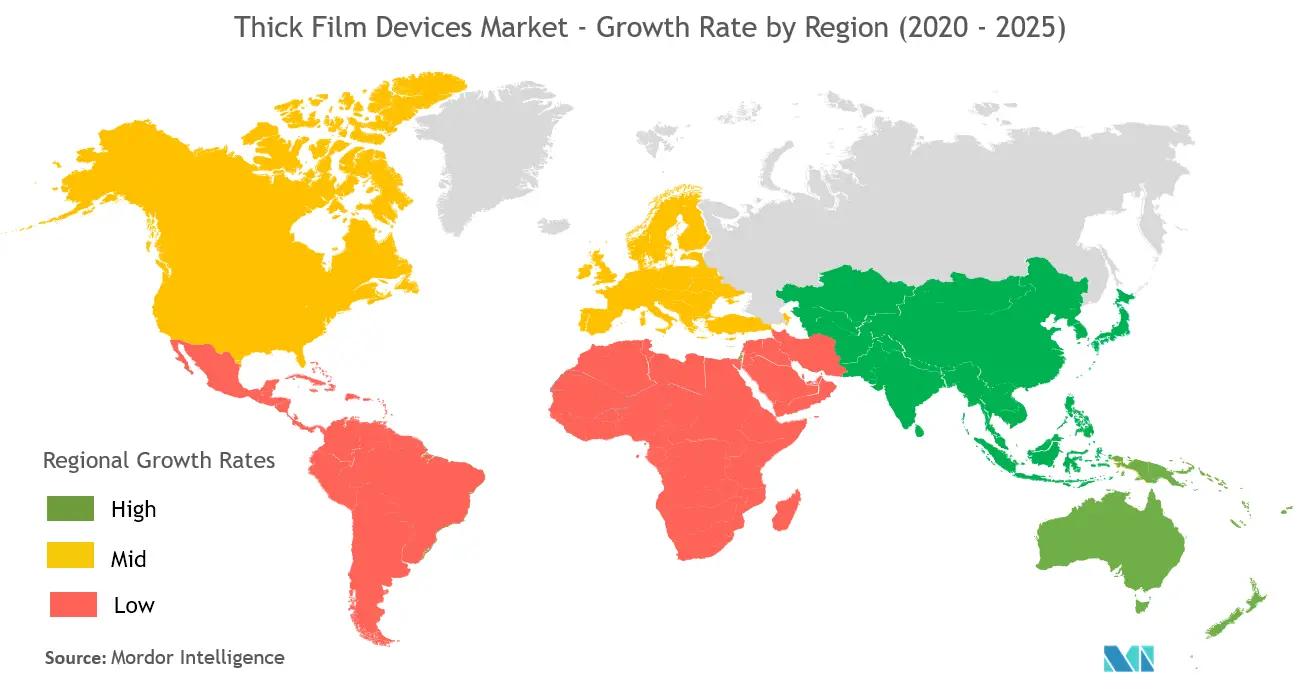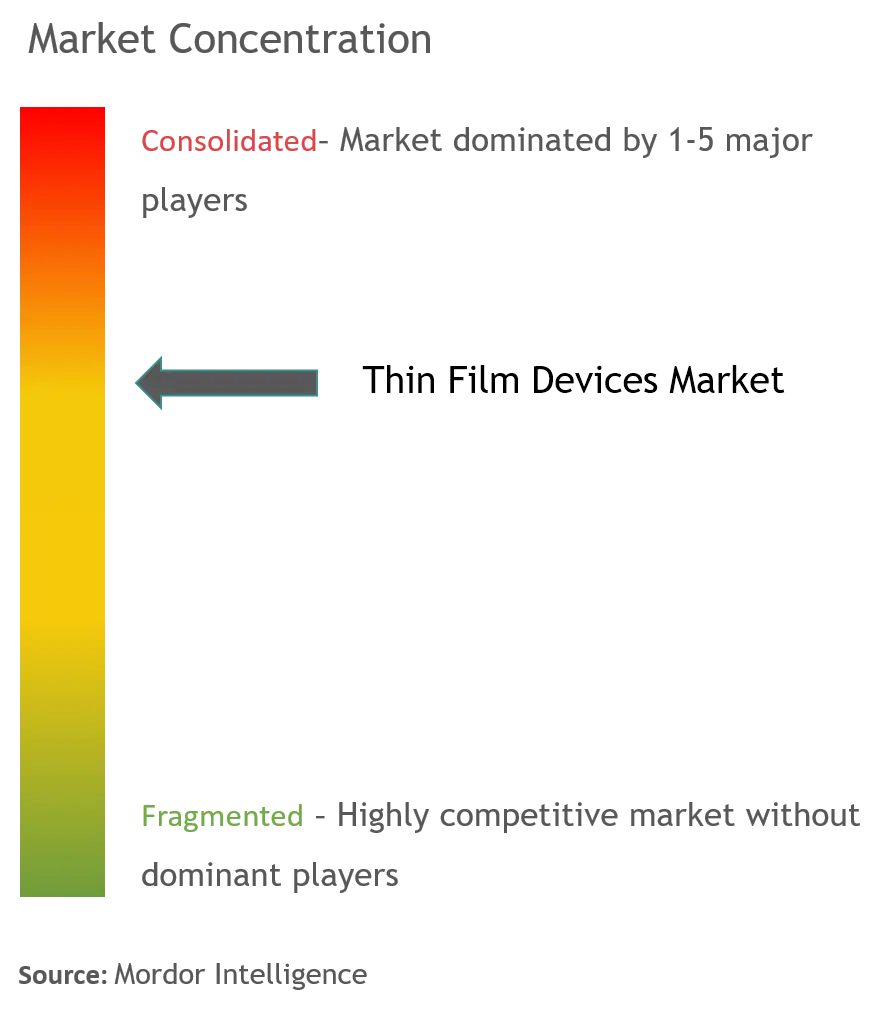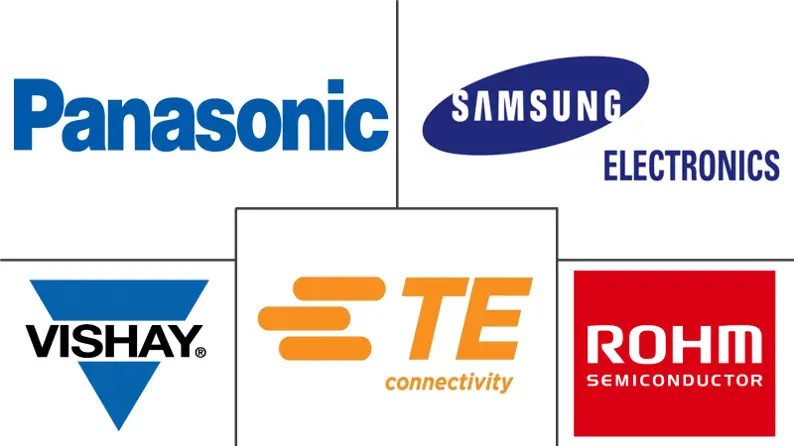Thick Film Devices Market Size and Share

Thick Film Devices Market Analysis by Mordor Intelligence
The Thick Film Devices Market is expected to register a CAGR of 14.04% during the forecast period.
- For instance, in April 2020, Bourns, Inc. announced the availability of a new AEC-Q200 compliant series of thick film chip resistors -- Model CRxxxxA series. It is designed in five different versions to support specific application requirements -- CR standard, CR-PF ultra-low lead content, CR-AS sulfur resistant, CRxxxxA-AS AEC-Q200 compliant, and sulfur resistant and CRxxxxA AEC-Q200 compliant. In May 2019, ATE Electronics had released the next power level thick film resistor PR800. This new resistor has a 30% higher power capability than the latest PR600 with the same footprint of 57(65) x 60mm.
- The growing technological advancements in the sector is also expanding thick film devices' industrial adoption. Growing demand for MEMS (microelectromechanical systems) and multi-layer ceramic capacitors are also expected to fuel the demand for thick film technology over the forecast period. However, in 2019, thick film chip resistor and MLCC manufacturers experienced price increases in feedstock metals, which is also a capable passive component industry. It is estimated that variable costs to produce MLCC and thick film chip resistors (which are the two-mass produced passive components) amount to about 70-80% of the cost of goods sold in various passive electronic component industries.
- Increasingly demanding technical requirements have exposed the limits of the standard thick-film technologies used to produce circuit-board conductors. However, companies are also investing in developing a new generation of thick-film pastes, and their photolithographic structuring enables the manufacturing of extremely high-resolution thick-film structures necessary for advanced applications, like 5G technology.
- For instance, researchers from the Fraunhofer Institute for Ceramic Technologies and Systems IKTS, in collaboration with MOZAIK, a UK-based company, have developed conductors based on screen-printing technology with a resolution of 20 micrometers or less. They claim that the process is suitable for industrial applications (especially 5G) and mass production, and the investment costs are low.
- The spread of the novel Corona Virus has severely affected the market studied. This is because of the sudden shutdown of factories along with a ban on international flights. In modern manufacturing history, demand, supply, and workforce availability for the first time are affected globally at the same time. Thick film devices manufacturing requires people to be physically on-site. Most of the factories making these devices are not designed to be managed remotely. February 2020 also witnessed the biggest-ever fall in the history of the worldwide smartphone market. Due to the dampened sales of these durables, the market vendors' operating profit has drastically decreased.
Global Thick Film Devices Market Trends and Insights
Automotive to Expected to Hold Significant Share
- Over the last two decades, the growing production of automobiles is a significant factor in driving market growth due to the high adoption of electrical and electronic devices in automotive manufacturing. In the United States, all heavy trucks must be installed with electronic logging devices (ELD) from the US Department of Transportation’s Federal Motor Carrier Safety Administration (FMCSA) by the end of 2019.
- These government regulations would increase the demand for thick film devices, and hence, may expand the studied market vendor’s growth scope further. For instance, Canada-based thick film heating element manufacturer, Datec Coating Corporation, was awarded a USD 1.3 million contract by the Innovation, Science and Economic Development Canada (ISED), a government organization that works toward improving investment scenario for several industries in Canada, for Automotive Supplier Innovation Program. In October 2018, the firm also received a significant investment by Germany-based E.G.O.- Group mainly for its manufacturing expansion.
- A new technology called thick-film-on-steel promises to yield a new class of resistors for a wide range of applications. Resistors made using the technology can operate at temperatures up to 400°C and target various automotive applications. The devices are produced by combining a thick ceramic dielectric glaze with stainless steel to form a three-layer product that can be created, molded, welded, and holes to be added for mounting.
- With the outbreak of COVID-19, automotive and consumer electronics are two of the most negatively affected end-users, which heavily use thick film devices. For instance, Fiat Chrysler’s first-quarter sales in the US have dropped by 10%, and General Motors sales for the same period has fallen by 7%. After initial supply and manufacturing disruptions, the automotive industry is experiencing a demand shock with uncertain recovery timeline due to shelter -in -place regulations. With limited room to cut fixed costs, some OEMs have low liquidity to power through a long period of missing revenues, which could affect the thick film devices market.

Asia-Pacific to Witness the Highest Growth
- Asia-Pacific is one of the most significant regions for the thick film devices market, mainly due to government policies favoring the growth of semiconductor manufacturing. Also, the region is the largest producer of consumer electronics. Also, the Chinese government raised around USD 23-30 billion to pay for the second phase of its National IC Investment Fund. Moreover, the growth of the food processing industry in China and India is further expected to fuel the demand for the thick film devices market.
- The expansion of the semiconductor industry throughout the region and the rising adoption of MEMS among various industries are bolstering the demand for thick film devices in the region. For instance, the consumption of semiconductors is rapidly increasing in China, compared to other countries, owing to the continuing transfer of global, diverse electronic equipment to China, wherein the product is a necessary component. China is home to three of the top five largest smartphone companies worldwide, posing tremendous opportunities for the thick film device market.
- According to India Electronics and Semiconductor Association, the semiconductor component market in the country is expected to be worth USD 32.35 billion by 2025, while displaying a CAGR of 10.1% (2018-2025). The report states that the country is a lucrative destination for global R&D centers. Thus, the government's ongoing Make in India initiative is expected to result in investments in the semiconductor industry in the country, further providing ample opportunities for the market.
- However, the spread of novel coronavirus has impacted the operations of vendors operating in these regions. For instance, Murata Manufacturing, Samsung, and Panasonic all have reported a drop in net sales in Q1 2020 due to the slowdown of manufacturing facilities. The anticipated trend is expected to continue until the pandemic ends.

Competitive Landscape
The thick film devices market is consolidated due to a significant share of the market is occupied by top players. Moreover, the new player finds it difficult to enter the market due to the strong dominance of existing players. Some of the key players include Panasonic Corporation, Samsung Electronics Co. Ltd, Vishay Intertechnology Inc., TE Connectivity Ltd, KOA Speer Electronics, Inc., and AVX Corporation others.
- April 2020 - Panasonic Corporation introduced NEW ERJ-UP3 Series Anti-Sulfurated Thick Film Chip Resistors, Anti-Surge Type in 0603-inch case size. It is designed to be extremely durable in challenging or unclean, harsh environments. It provides anti-sulfurization characteristics that avoid an open circuit caused by a sulfide disconnection.
- February 2020 - Vishay Intertechnology, Inc. introduced the first high power resistors on the market to be offered with its AEC-Q200 qualified thick film high power resistors. It is designed for direct mounting on a heatsink. The company's Sfernice LPSA range of products delivers high power dissipation and pulse handling capabilities, which in turn helps the designers to reduce component counts and lower costs in automotive applications.
Thick Film Devices Industry Leaders
-
Panasonic Corporation
-
Samsung Electronics Co. Ltd
-
TE Connectivity Ltd
-
Vishay Intertechnology Inc.
-
Rohm Semiconductor GmbH
- *Disclaimer: Major Players sorted in no particular order

Global Thick Film Devices Market Report Scope
Thick film devices are single-layered or multi-layered structures that are made up by the deposition of a formulated paste on a substrate. The substrate is made of different materials such as ceramic, polymer, and metals. The layer deposited on the substrate facilitates mechanical, electrical, and chemical functionality for the device, in which the coating is fabricated. Thick film devices are widely used in energy devices such as photovoltaic cells and fuel cells as well as in electronic devices such as capacitors and circuit devices. Moreover, the thick film devices find their use in mechanical and chemical apparatus, which consist of optical sensors and piezoelectric devices.
| Capacitors |
| Resistors |
| Photovoltaic cells |
| Heaters |
| Other Types |
| Automotive |
| Healthcare |
| Consumer Electronics |
| Infrastructure |
| Other End-user Industries |
| North America |
| Europe |
| Asia-Pacific |
| Rest of the World |
| By Type | Capacitors |
| Resistors | |
| Photovoltaic cells | |
| Heaters | |
| Other Types | |
| By End-user Industry | Automotive |
| Healthcare | |
| Consumer Electronics | |
| Infrastructure | |
| Other End-user Industries | |
| Geography | North America |
| Europe | |
| Asia-Pacific | |
| Rest of the World |
Key Questions Answered in the Report
What is the current Thick Film Devices Market size?
The Thick Film Devices Market is projected to register a CAGR of 14.04% during the forecast period (2025-2030)
Who are the key players in Thick Film Devices Market?
Panasonic Corporation, Samsung Electronics Co. Ltd, TE Connectivity Ltd, Vishay Intertechnology Inc. and Rohm Semiconductor GmbH are the major companies operating in the Thick Film Devices Market.
Which is the fastest growing region in Thick Film Devices Market?
Asia Pacific is estimated to grow at the highest CAGR over the forecast period (2025-2030).
Which region has the biggest share in Thick Film Devices Market?
In 2025, the Asia Pacific accounts for the largest market share in Thick Film Devices Market.
What years does this Thick Film Devices Market cover?
The report covers the Thick Film Devices Market historical market size for years: 2019, 2020, 2021, 2022, 2023 and 2024. The report also forecasts the Thick Film Devices Market size for years: 2025, 2026, 2027, 2028, 2029 and 2030.
Page last updated on:
Thick Film Devices Market Report
Statistics for the 2025 Thick Film Devices market share, size and revenue growth rate, created by Mordor Intelligence™ Industry Reports. Thick Film Devices analysis includes a market forecast outlook for 2025 to 2030 and historical overview. Get a sample of this industry analysis as a free report PDF download.



